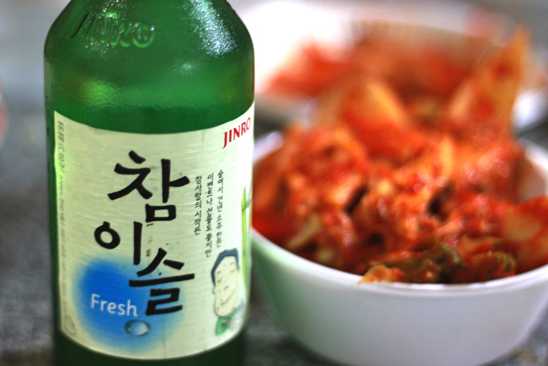(单词翻译:单击)
This list is created with people who are new to Korean food in mind.It looks at 5 things I had to learn through research that are not immediately obvious to us non-Koreans. Learning these tips will help you when you are dining in a Korean restaurant or in a Korean friend’s home.
这个列表是针对初次接触韩国食物的人创建的。表中罗列了五件对于非韩国人而言必须知道却不太浅显的事。当你在韩国餐馆或者韩国朋友家里就餐时学到的这些可以帮到你。
You should keep in mind that Koreans are generally very pleased to see someone making an effort to know their culture and they will definitely overlook any errors of etiquette you may have. So don’t be nervous when eating – enjoy the delicious food and good company.
你应该注意到了韩国人普遍非常乐于看到人们想要学习他们的文化,并且他们会忽略你可能会有的一些礼节性错误。所以吃饭的时候不要太紧张,和好朋友一起享受美味的食物就好了。
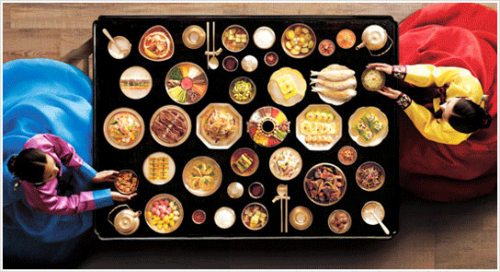
1. Metal Chopsticks
金属筷子
Unlike the Chinese and Japanese who use wooden chopsticks, Koreans usually use metal chopsticks. In fact, metal has been the material of choice for chopsticks in Korea since the 6th century AD.
不像中国人和日本人使用木筷子,韩国人常常使用的是金属筷子。实际上,在公元6世纪在韩国就用金属制作筷子了。
The reason for using metal over wood is unclear but some theories suggest it was for hygiene reasons, or the scarcity of quality timber making metal cheap. The other unique thing about Korean chopsticks is that they are always accompanied by a metal spoon.
使用金属筷子而非木筷子的原因尚不清楚,但是一些理论表明是卫生方面的原因。或者是优质木材的奇缺使金属制筷子更为便宜。另一个韩国筷子的特点是它们总是伴随着金属勺。
This is because of the large number of soup-like dishes eaten at a Korean meal. In fact, most Korean meals involve soup and rice primarily (with kimchi on the side of course), with other side dishes being optional. When setting the table, the spoon always goes to the left of the chopsticks.
这是因为韩国餐饮中有大量汤类食物。事实上,大部分韩国食物以汤和米饭为主(泡菜在一边),另一边的食物随意,勺子总是被放在筷子的左边。
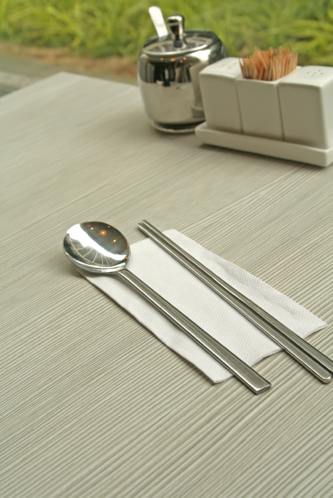
2. What goes where?
如何摆放?
There is a particular order to the placement of things on a Korean table. At each place setting you have rice, then to its right you have soup, then the chopsticks on the far right. Stews and side dishes are arranged in the center of the table for everyone to share. And when I mean share, I mean it – even the stews are usually eaten by everyone from a communal pot. When sharing from a communal pot make sure your spoon is very clean – this is done with the mouth – not a napkin. In other words, when eating off your spoon don’t leave anything behind before dipping it again. [Image © Visit Korea]
韩式餐桌物品的摆放是有一定秩序的。首先从摆放米饭的位置开始,在它的右侧是放汤的位置,筷子则是放在右侧较远的地方。炖菜和配菜应放在桌子的中央,让大家可以一起分享。我这里所说的分享,是指大家从一个公共的盆里夹取食物。而当你要从盆里夹取食物的时候,记得保证汤勺是干净的。但千万不要有纸巾来擦干净,而是用你的嘴巴。换句话说,在你再次蘸取以前,保证汤勺离开你的嘴的时候没有残留任何食物。
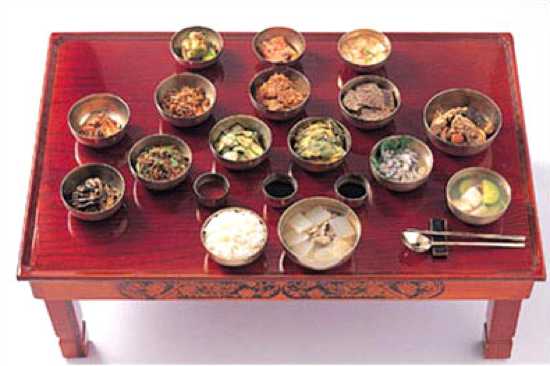
3. Right Tools
正确的工具
You should use the right tools for the job – in Korean food that means you eat your rice with a spoon. So often on video clips online of non-Koreans eating bibimbap (mixed rice) you see them struggling to stir up their rice and vegetables with their chopsticks. They should be using a spoon! It is very easy to mix up bibimbap this way and, of course, it means you get to eat it much faster as everything must be mixed well first. The spoon is also used for soups, stews, and porridges. Chopsticks are there to help you pick up pieces of meat or vegetables from a barbecue if one is in use, or to take side dishes. [Image © Kyle Strickland]
吃饭时须用对工具——这句话放在韩国食物中意思是吃米饭要用勺。在网上的视频短片中,你可以常常看到非韩国人吃石锅拌饭(什锦饭)时在努力地用筷子搅拌米饭和蔬菜。他们应该用勺!这样的话搅拌石锅拌饭就很容易了,而且由于开吃之前必须先将石锅拌饭里的一切东西搅拌均匀,当然这也意味着你可以更快地开吃。勺也用于喝汤、吃炖菜和喝粥。在韩国筷子如被使用,是用来帮你从烧烤架上夹起肉片或蔬菜,或者用来吃一些配菜。
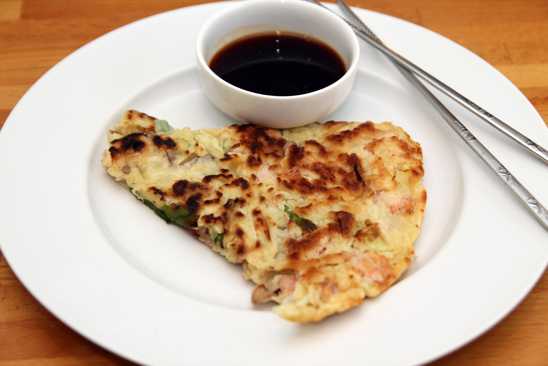
4. Good Manners
好的礼仪
It can be considered rude if you don’t eat all of your rice. It is not necessary to finish all of the side dishes on the table, but the rice is a must. You should never blow your nose at the table – this is considered to be one of the rudest actions possible. Other banned acts: leaving chopsticks in your bowl between bites, eating with your mouth open, talking with your mouth full, overeating, and using your hands to pick up dishes. You should also not start eating before the oldest person at the table starts. When you have finished eating, your spoon and chopsticks return to the place from whence they came: on the table. You should never leave utensils poking out of dishes.
如果你不吃完碗里所有的饭,会被认为是没有教养的。桌子上的菜可以不吃完,但是米饭是必须吃完。也不要在饭桌上擤鼻涕,这也被认为是最不礼貌的行为之一。其他禁止的行为还包括:咀嚼的时候把筷子放在碗里;咀嚼的时候张嘴;嘴里有东西的时候说话;吃得太多;用手吃等等。在吃饭前,你应当在最年长的人开吃之后才动筷。当你吃完饭了以后,把你的汤勺和筷子放到它们在桌面上最初的位置。不要用餐具戳碰除了饭菜以外的东西。

5. Drinking Manners
饮酒礼仪
At the table you should not pour your own liquor – someone else will pour it for you (hold your glass with two hands while it is being filled), and in turn, you should pour drinks for them. If you are serving a drink to someone older than you, use two hands to hold the bottle – otherwise one handed is fine. Make sure your companion’s glass is never empty. This next rule may sound tedious, but Koreans are much more aware of social order so it is quite important. When drinking with someone higher than you on the social ladder (either in age, business rank, or social rank) you should turn your head away from them when you take a sip. This is done as a sign of deference.
在餐桌上你不应该自己为自己倒酒——有人会为你倒的(倒酒时你必须用双手捧起杯子),反过来,你也应该为他们倒酒。如果给比你年长的人倒酒,那么拿起酒瓶时要用双手,如果同伴并非比你年长,那么一只手拿酒瓶也可以。确保你同伴的杯子里总是有酒。下一个规矩可能听起来很无趣,但韩国人更加注重社会秩序,所以这条规矩相当重要。与比你社会阶层(在年龄、职级或社会地位方面)高的人一起喝酒时,在喝一小口时,你不应该面对着他们,而应该把头扭开。这是一个表达敬意的姿态。
